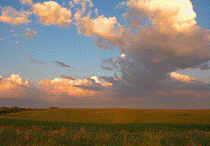North American Prairie Conference
Date of this Version
2004
Abstract
During the past 50 years increasing agricultural practices have transformed native habitats into row~crop fields, making the Conservation Reserve Program (CRP) grass lands important habitat for wildlife populations. Limited information exists on how nongame grassland bird species relate to different stand ages and cover types of Conservation Reserve Program. Conservation Reserve Program grassland study sites (n = 42) were stratified by stand age (old [10-13 years] and new [0-3 years] grasslands), and cover types (CPI-cool-season grasslands and CPZ-warm-season grasslands) in eastern South Dakota. Field age rather than cover type was more predictive of grassland bird occurrence and density. Sedge wrens (Cistothorus platensis), common yellowthroats (Geothlypis mchas), savannah sparrows (Passerculus sandwichensis), and bobolinks (Dolichonyx oryzivorus) reached their highest occurrence and/or densities in old CRP grasslands while upland sandpipers (Bartramia longicauda), western meadowlarks (Stumella neglecta), and vesper sparrows (Pooecetes gramineus) reached their highest densities in new eRP plantings. Grasshopper sparrow (Ammodramus savannarum) and dickcissel (Spiza americana) occurrence and density were more closely associated with temporal changes in vegetation structure. No species was consistently associated with cool- or warm-season grasslands. Based on our find ings, we submit that extending ten-year CRP contracts for another five to ten years is justified relative to grassland birds.


Comments
Published in Dave Egan & John A. Harrington, editors, Proceedings of the 19th North American Prairie Conference: The Conservation Legacy Lives On..., University of Wisconsin-Madison, August 8-12, 2004 (Proceedings of the North American Prairie Conference, 19), Madison, WI: University of Wisconsin-Madison, 2004.